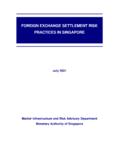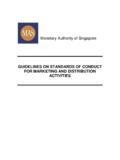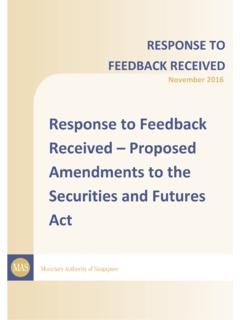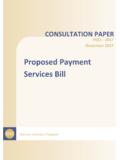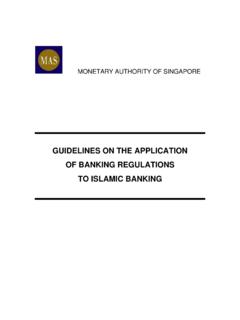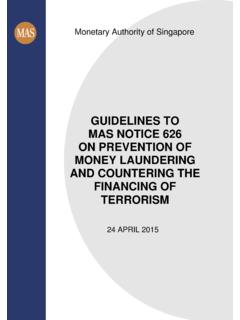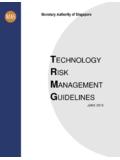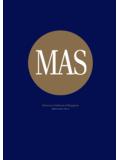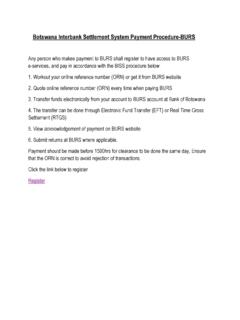Transcription of PROJECT UBIN PHASE 2 - Monetary Authority of Singapore
1 Powered by: PROJECT ubin PHASE 2Re-imagining Interbank Real-Time gross settlement System Using Distributed Ledger TechnologiesNOVEMBER 20172 | PROJECT ubin PHASE 2 RE-IMAGINING RTGSFOREWORDThe Monetary Authority of Singapore (MAS) and The Association of Banks in Singapore (ABS) are pleased to present the report Re-imagining Interbank Real-Time gross settlement System using Distributed Ledger Technologies .The report shares the findings from PROJECT ubin PHASE 2, a collaborative industry PROJECT with 11 financial institutions, four technology partners and ubin 's journey started a year ago with the development of a basic prototype on Ethereum in PHASE 1.
2 This first step in the exploration of Distributed Ledger Technology (DLT) opened up a world of opportunities, while also uncovering new challenges and 2 is focused on solving the key challenges identified around the need for transactional privacy and deterministic finality, and most critically, the ability to perform multilateral netting capabilities in a decentralised manner while preserving transactional were developed on three leading DLT platforms: Corda, Hyperledger Fabric and Quorum, to explore the different models made possible by the varied capabilities and features of the three DLT successful completion of the PROJECT solved a major challenge faced by the DLT community, and opens up opportunity for wider adoption of DLT-based settlement systems.
3 We are sharing our learnings and knowledge from PROJECT ubin to encourage greater experimentation amongst central banks and financial hope that you would gain a better understanding of developing solutions on the three commonly used DLT platforms, and be inspired to challenge the traditional thinking of centralised architecture, and re-imagine the design of future financial would like to express our gratitude and thanks to the 11 participating financial institutions, four technology partners and Accenture, who came together in an open and transparent manner to work on the PROJECT . We see immense benefits from a successful industry collaboration that creates a vibrant commend this report to you and hope that you will be as excited as we are in its potential to help us provide better services to our customers in a faster, more secure and less costly ubin PHASE 2 RE-IMAGINING RTGS | 3 Sopnendu MohantyCo-Chair, PROJECT ubin PHASE 2 Chief FinTech Officer Monetary Authority of SingaporeOng-Ang Ai Boon, MrsCo-Chair.
4 PROJECT ubin PHASE 2 Director The Association of Banks in Singapore4 | PROJECT ubin PHASE 2 RE-IMAGINING RTGSP roject ubin PHASE 2 is a collaborative design and rapid prototyping PROJECT , exploring the use of Distributed Ledger Technologies (DLT) for Real-Time gross settlement (RTGS) System. ubin PHASE 2 is led by the Monetary Authority of Singapore (MAS) and The Association of Banks in Singapore (ABS). It is managed and delivered by Accenture, with a consortium of 11 financial institutions in Singapore : Bank of America Merrill Lynch, Citi, Credit Suisse, DBS Bank Ltd, HSBC Limited, Morgan, Mitsubishi UFJ Financial Group, OCBC Bank, Singapore Exchange, Standard Chartered Bank and United Overseas ubin PHASE 2 RE-IMAGINING RTGS | 5 01 | Executive Summary.
5 602 | Introduction .. Background .. Objectives and Approach of ubin PHASE | Scope and System Designs .. Overall Functional Scope .. Workstream Characteristics and Design Considerations ..1304 | Key Functional Design .. Fund Transfer .. Queue Mechanism .. Gridlock Resolution ..2805 | Key Observations and Findings .. Corda .. Hyperledger Fabric .. Quorum .. Microsoft Azure ..4706 | Future Considerations ..4807 | Conclusion ..5208 | Acknowledgement ..5409 | Glossary ..5810 | Appendix ..60 CONTENTS6 | PROJECT ubin PHASE 2 RE-IMAGINING RTGSEXECUTIVE SUMMARYUbin PHASE 2 is a collaborative PROJECT led by The Monetary Authority of Singapore (MAS) and The Association of Banks in Singapore (ABS).
6 It is managed and delivered by Accenture, with participation from 11 financial institutions. The 13 week PROJECT explores the use of Distributed Ledger Technology (DLT) for specific Real Time gross settlement (RTGS) functionalities. Particularly, it focuses on the feasibility of decentralising Liquidity Saving Mechanisms (LSM), while maintaining privacy of banking transactions. Leveraging the capabilities of the Accenture Liquid Studio and its Liquid Delivery Methodology with Microsoft Azure as the cloud platform, three prototypes were developed by three workstreams on three different DLT platforms: Corda, Hyperledger Fabric and Quorum.
7 The prototypes successfully demonstrate several points. Firstly, that key functions of a RTGS system such as fund transfer, queueing mechanism and gridlock resolution can be achieved through different techniques and solution designs. Secondly, decentralising the key functions of a RTGS system may not only mitigate the inherent risks of a centralised system, such as single point of failure, but may also affirm the promised benefits of DLT, for example cryptographic security and that privacy is paramount in an interbank payment system, this PROJECT validates that privacy of RTGS transactions may be ensured by all workstreams with their distinct methods.
8 Specifically, Corda with its Unspent Transaction Output (UTXO) model and confidential identities, Hyperledger Fabric leveraging its Channels design, and Quorum using Constellation and zero knowledge proofs (ZKP). Other observations and findings from this PROJECT include the scalability and resilience of the three designs. Significantly, this PROJECT concludes that all three workstream designs have successfully demonstrated the feasibility of removing a central infrastructure operator in a DLT-based RTGS system. Therefore, with the feasibility of DLT in a RTGS system, the role of MAS as an infrastructure operator in facilitating interbank payments needs to be PHASE 2 not only successfully demonstrates that RTGS functions may be decentralised without comprising privacy, but also marks the success and significance of an industry-wide collaboration in laying the foundation for future innovation.
9 01 PROJECT ubin PHASE 2 RE-IMAGINING RTGS | 7 PROJECT UbinIn late 2016, in line with the vision for Singapore to become a Smart Financial Centre, the Monetary Authority of Singapore (MAS) commenced a collaborative PROJECT with 11 leading financial institutions and 5 technology providers. It explores the use of Distributed Ledger Technology (DLT) for clearing and settlement of payments and securities. The goal of this endeavour, known as PROJECT ubin , was for MAS and the financial industry to gain a better understanding of DLT and the feasibility of developing more resilient and efficient alternatives to today s financial market operations and PHASE 1, a proof of concept was conducted on Ethereum, testing the feasibility of using a central-bank-issued digital currency (SGD equivalent) for interbank payments.
10 ubin PHASE 2, managed and developed by Accenture, assesses the potential implications of deploying DLT for specific RTGS functionalities by focusing on Liquidity Saving Mechanism (LSM). It is also an objective of PHASE 2 to understand how real-time gross settlement privacy can be ensured using Figure 1: Overall Journey of PROJECT UbinPHASE 2 Achieved gridlock resolution and LSM on a decentralised system without compromising on privacy (focus of this report)FUTURE phases OF PROJECT UBINPHASE 1 Use of digital currency in RTGSD omestic Delivery vs Payment (DvP)Securities settlementPayment vs Payment (PvP)Cross-border settlementCross-border settlement of payments and securities (DvPvP)Target Operating ModelProcesses & policy impact8 | PROJECT ubin PHASE 2 RE-IMAGINING Real-Time gross settlement SystemReal Time gross settlement (RTGS)
